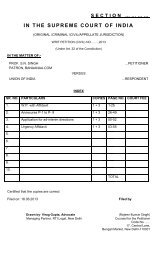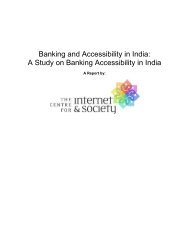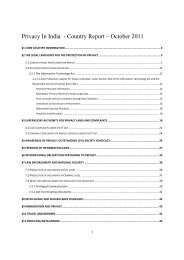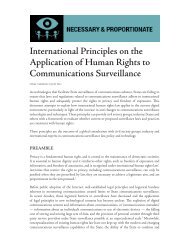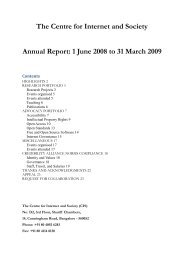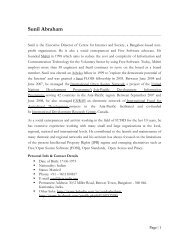Open Access to Scholarly Literature in India - Centre for Internet and ...
Open Access to Scholarly Literature in India - Centre for Internet and ...
Open Access to Scholarly Literature in India - Centre for Internet and ...
Create successful ePaper yourself
Turn your PDF publications into a flip-book with our unique Google optimized e-Paper software.
239-250. The map, created us<strong>in</strong>g data from SCI <strong>and</strong> SSCI (Thomson Reuters), a p-<br />
peared orig<strong>in</strong>ally <strong>in</strong> Maps of Science. 145<br />
Science can be thought of as conta<strong>in</strong><strong>in</strong>g themes <strong>and</strong> paradigms. Themes are areas of<br />
current research, while paradigms comprise the dom<strong>in</strong>ant <strong>to</strong>ol sets <strong>and</strong> exist<strong>in</strong>g knowledge<br />
that are used by <strong>to</strong>day’s researchers. This map shows 776 major paradigms <strong>in</strong> science<br />
along with the dom<strong>in</strong>ant relationships between these paradigms. Paradigms are<br />
shown as circles; strong relationships between paradigms are <strong>in</strong>dicated by the l<strong>in</strong>es connect<strong>in</strong>g<br />
the circles. The map was created by recursively cluster<strong>in</strong>g the 820,000 papers<br />
referenced most often <strong>in</strong> 2003. Cluster<strong>in</strong>g at each level was done us<strong>in</strong>g VxOrd, a <strong>for</strong>cedirected<br />
graph layout rout<strong>in</strong>e. These papers <strong>for</strong>med 53,000 clusters, 6,100 higher-level<br />
clusters, <strong>and</strong> f<strong>in</strong>ally 776 paradigms. Although each paradigm conta<strong>in</strong>s, on average, 1000<br />
papers, some are larger <strong>and</strong> some are smaller, as shown by different sized circles on the<br />
map.<br />
The r<strong>in</strong>g-like structure that <strong>for</strong>med by scientific paradigms is very robust. We f<strong>in</strong>d<br />
similar structures <strong>for</strong> different years, <strong>and</strong> <strong>for</strong> maps generated from scientific journals.<br />
“The structure of Science”, a galaxy map shown <strong>in</strong> the first iteration of Places & Spaces,<br />
is a map based on cluster<strong>in</strong>g of scientific journals, with superimposition of papers on the<br />
journal structure, whereas this map was generated directly from highly-cited papers. “The<br />
Structure of Science” shows current science <strong>in</strong> a discipl<strong>in</strong>ary context, while this map<br />
shows the breadth of discipl<strong>in</strong>es that contribute <strong>to</strong> s<strong>in</strong>gle paradigms.<br />
Because of the robust nature of the structure of science paradigms, we have placed<br />
our 776 scientific paradigms with<strong>in</strong> a reference system conta<strong>in</strong><strong>in</strong>g 12 radial slices <strong>and</strong> 6<br />
r<strong>in</strong>gs. This allows the position of each paradigm <strong>to</strong> be codified <strong>and</strong> available <strong>for</strong> lookup;<br />
<strong>for</strong> <strong>in</strong>stance Fluid Mechanics paradigms are <strong>in</strong> grid B3.<br />
We have also calculated <strong>and</strong> displayed the vitality of each paradigm. Vitality is a<br />
measure of the speed at which a group of researchers reaches consensus about major improvements.<br />
Paradigms are constantly be<strong>in</strong>g improved, but it usually takes years <strong>to</strong> reach<br />
consensus about which improvements are major. The white circles represent communities<br />
where consensus is reached relatively slowly. This is a common phenomenon <strong>in</strong> the<br />
social sciences, ecological sciences, computer sciences, <strong>and</strong> mathematics discipl<strong>in</strong>es.<br />
The red circles represent communities of researchers where consensus is reached relatively<br />
rapidly. This is more common <strong>in</strong> physics, chemistry, biochemistry <strong>and</strong> many<br />
medical discipl<strong>in</strong>es. Very dark circles (such as those <strong>in</strong> Astrophysics L5 -6) represent<br />
communities where consensus is reached extremely quickly.<br />
The map of scientific paradigms <strong>and</strong> its reference system can be used <strong>for</strong> multiple<br />
purposes. Countries, <strong>in</strong>dustries, companies, universities, <strong>and</strong> <strong>in</strong>dividual researchers can<br />
145 http://www.mapofscience.com.<br />
Page | 84




